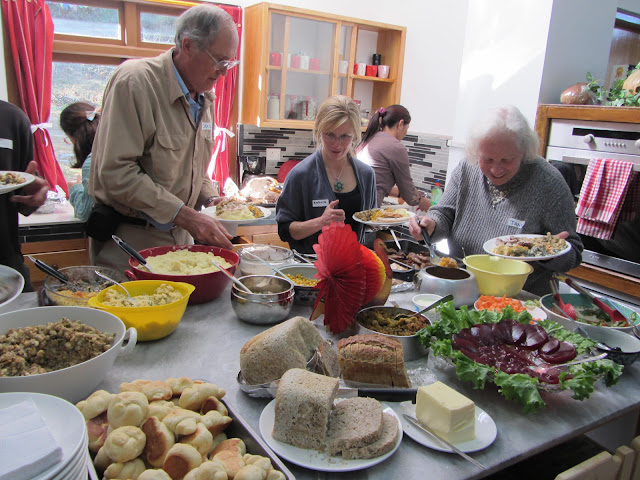As you are fully aware, last week was the American holiday of Thanksgiving. Of course, Thanksgiving is not celebrated at all in Bhutan (why would it be?). There aren't even any turkeys in Asia! Nevertheless, Emily and I managed to celebrate Thanksgiving both in a Bhutanese way, and then in a full-blown American way.
First, on the actual day of Thanksgiving (last Thursday), Emily and I went out for a big meal with our good friend Samir and two new Bhutanese staff at RTC. We went to a good local place called Ama and ordered lots of Bhutanese and Indian food. We had Bhutanese red rice, dal, paneer curry, dried beef, peanut masala, momos, fish curry, chicken chili chop, fried potatoes, and washed it down with Druk 11000 "super strong" beer. After our feast, we went to Ambient Cafe for dessert. Emily took some pictures on her phone, which she arranged below:
 |
| Before and after at Restaurant Ama. |
 |
| Before and after at Ambient Cafe. |
Last Saturday we were invited to a good-ol' American Thanksgiving at the lavish home of the American 'Wardens' to Bhutan. I had to look up at the U.S. State Department website what exactly a diplomatic 'warden' is, and it told me that a warden is a volunteer diplomatic liaison for American ex-pats in places where the United States does not have diplomatic relationships. This, of course, includes Bhutan. If we ever lost our passport, or get in trouble with the police, or have immigration issues, Emily and I will turn to the wardens for help. Apparently Rob at RTC is also a warden, which we were unaware until he told us on Saturday.
The 'U.S. wardens to Bhutan' invited all of the Americans living in Bhutan to a Thanksgiving feast. There are, apparently, only about three dozen Americans living in Bhutan, which is quite low relatively speaking (for comparison, in Switzerland, roughly the same land area of Bhutan, there are over 18,600 American expats). Fourteen of those Americans work at RTC, and the rest have various positions teaching, working at the hospital, or consulting for various organizations. As you have probably learned from us, Bhutan is an extremely difficult country to enter and work.
We arrived at the house of the wardens (a doctor and his wife) and were immediately struck by the immense concentration of wealth in this house. If this house were placed amongst an upper middle-class neighborhood in the United States I wouldn't even blink, but this stuck out like a sore-thumb here in Bhutan. There was a stone fireplace and central heat, five bathrooms, five bedrooms, a kitchen with a full-fledged oven and a dishwasher, and many other extravagances. The couple had their own driver and their own chef. Seriously, it was a shock to encounter all of this in a country where a lot of communities don't even have electricity or roads. Bhutan is not a desperately poor country, like others Emily and I have seen, but there is not much extravagance save for a few pockets in Thimphu.
But the wardens were also generous, and were volunteering in Bhutan in different capacities. They imported a lot of food to feed us all, including a frozen turkey from the U.S. that was shipped with dry ice! While there was some embarrassment of riches going on for us, we very much welcomed all of the foods from home that we miss. While the wardens provided much of the food, everyone brought a dish to share as well. Emily made turnips in browned butter, which people enjoyed. There was also several kinds of stuffing, and breads, and mashed potatoes, and green bean casserole, and all sorts of other vegetables. There was even an honest-to-god cheese ball with crackers that was absolutely fabulous. For dessert there was real pumpkin pie (several, in fact), brownies, cinnamon rolls, apple strudel, and other delectables. Escaping from our normal diet of rice and stir fries and ema datsi, we gorged ourselves on the rich foods from home. I was so full my sides hurt into Sunday, but it was worth it. As they say, "you don't miss it till it's gone."
 |
| Chris (RTC), Cathy (RTC), and Rob (RTC) eagerly wait for the food. |
 |
| Dr. Solomon (the warden) says a few words. Robert, Janet (RTC), and Samir (RTC) are in the foreground. |
 |
| Digging into the feast. Doug (RTC), Antonia, and Janet (RTC). |
 |
| Samir is loving it. |
 |
| So so good. I realize living in Bhutan how much I miss turkey (and not just for Thanksgiving). |
 |
| Enjoying the meal. From left to right: Julia (RTC), James (Wheaton), Ali (Wheaton), Julie, Clint, Nancy (RTC), Ruby (Wheaton), Annie (Wheaton), and Meagan (Wheaton). |
 |
| Dessert. Somehow I managed to get even more food inside of me. |





































































